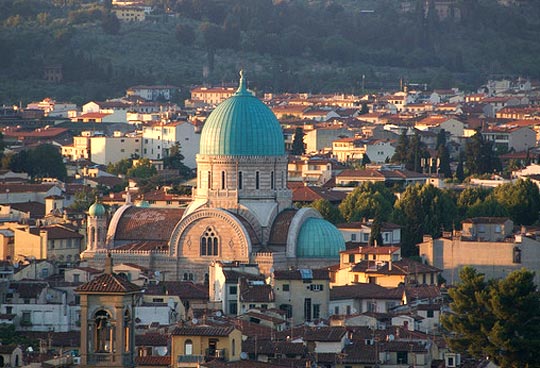June 17 Open House at the Synagogue & Jewish Museum

Florence’s historic Synagogue and Jewish Museum is celebrating its reopening to the general public after months of Covid restrictions with later afternoon and evening visits at no cost on Thursday, June 17, followed by a buffet of Hebrew specialties (€10) and a free concert in the garden.
From 5 to 7 pm, guides will explain Jewish history in Florence, beginning with the historic ghetto in what is now Piazza della Repubblica, demolished in the 1860s when the city was designated capital of Italy and the subsequent building of Synagogue, with particular attention paid to its architecture. The tour will also include a look at a show displaying a 17th century work depicting Moses by Il Guercino and a 20th century painting by another Italian artist, Gino Rossi, portraying Grazia Levi, who later was deported to Auschwitz in 1944. Reservations necessary at firenzebraica@operalaboratori.com.
Open beginning at 7 pm, the Synagogue garden will host a presentation of the upcoming Jewish Art and Culture Center of Florence at 7:30 pm. The Synagogue and the Jewish museum will be again accessible to visitors from 8 to 9 pm. Closing out the evening is a performance by the Balagan Café Orkestar conducted by Enrico Fink.
More information on the Facebook page and website.
The Synagogue was constructed in the 19th century when all Jews were forced to leave the “ghetto” of Florence, their home since 1571, complete with iron gates that were locked at sunset and opened every morning at dawn until 1848. The area comprised Piazza della Repubblica, Piazza dell’Olio, via Brunelleschi and Via Roma. Liberation from the ghetto was certainly welcome, but with the erasing of their ancient home, Jews found themselves having to recreate their “place” in the city. After much deliberation, a spot close to Piazza d’Azeglio was chosen, then a relatively new area still within the 13th century city walls.
Showing their close ties to the Catholic community, the temple commission chose one Jewish and two Catholic architects to build the splendid Moorish-style temple, inaugurated in 1882. These architects, Marco Treves, Mariano Falchini and Vincenzo Micheli, began in 1874 by settling the first stone, a block brought all the way from Jerusalem. They designed a three-story building with tall arches and a large copper dome set on intersecting barrel vaults.
Although definitely Eastern in style, the colors of the exterior are in keeping with Central Italian artistic tradition: alternating bands of pink and white marble are crowned by the oxidized and somewhat elongated dome. The impact of seeing this magnificent building is magnified by its setting in a lovely garden, complete with a palm tree and other exotic plants. Inside, the rich interior of the mosaic floors and frescoed walls captures one’s attention. As for religious services, the Florence synagogue follows an Italian version of the Sephardic rite common to Spain and Portugal.
Complemented with photos and multimedia exhibits, the Jewish Museum documents the history of Hebrew residents in Florence from their arrival in 1437 to the present day. The displays include a model of the Florence ghetto, plus objects for domestic use and home worship typical of Jewish households in addition to silver and textiles. (rosanna cirigliano)
